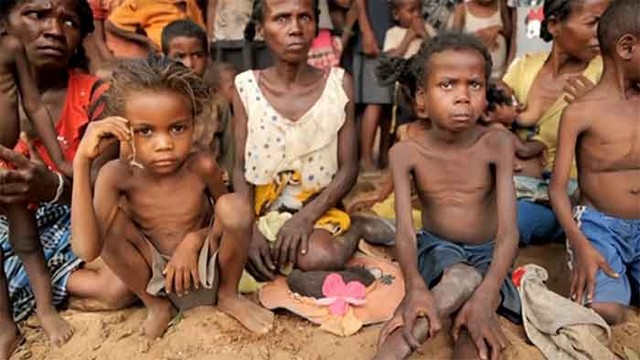By Countercurrents Collective
Climate crisis has pushed communities in Madagascar to the verge of starvation. The World Food Programme (WFP) says resources are scarce in the country after the worst drought in four decades.
The WFP said more than a quarter of people are suffering in one area. And $78.6 million is needed to fight the crisis.
Climate change is the driving force of a developing food crisis in southern Madagascar, the UN’s World Food Programme (WFP) has warned.
Acute malnutrition in Madagascar has almost doubled in just the last four months.
A mother of three said about children she takes care: “I rely on God. Today we have absolutely nothing to eat except cactus leaves that we are trying to clean up. We have nothing left. Their mother is dead and my husband is dead. What do you want me to say? Our life is all about looking for cactus leaves again and again to survive.”
David Beasley, WFP’s executive director, said: “It’s seven times worse than it was just a year ago. Seven times more children are in trouble. Why? Because of drought. We’re facing the worst drought in over 40 years, and this is an area where people depend on their own agriculture; home-grown school meals, smallholder farmers, this is how they live down here but with drought back to back to back, people can’t survive and so the government partnering with WFP and others we’re doing the best we can, but it’s a terrible situation.”
The African island has been plagued with back-to-back droughts — its worst in four decades — which have pushed 1.14 million people “right to the very edge of starvation,” said David Beasley in a news release Wednesday.
“I met women and children who were holding on for dear life, they’d walked for hours to get to our food distribution points. These were the ones who were healthy enough to make it,” Beasley said.
“Families are suffering and people are already dying from severe hunger. This is not because of war or conflict, this is because of climate change. This is an area of the world that has contributed nothing to climate change, but now, they’re the ones paying the highest price.”An estimated 14,000 people are already in catastrophic conditions, according to the WFP, a number that is predicted to double to 28,000 by October. Thousands in southern Madagascar have left their homes in search of food, while those who remain are resorting to extreme measures such as foraging for wild food to survive, the WFP said.
“This is enough to bring even the most hardened humanitarian to tears. Families have been living on raw red cactus fruits, wild leaves and locusts for months now. We can’t turn our backs on the people living here while the drought threatens thousands of innocent lives,” said Beasley.
“Now is the time to stand up, act and keep supporting the Malagasy government to hold back the tide of climate change and save lives.”
Beasley’s warning came a day after the WFP said 41 million people in 43 countries were now teetering on the edge of starvation, with 584,000 already experiencing famine-like conditions across Madagascar, Ethiopia, South Sudan, Nigeria, Burkina Faso and Yemen. This number has increased from 27 million in 2019.
Conflict, climate change and economic shocks are all driving the rises in hunger, the WFP said, with those pressures on food security compounded by steep price increases for basic foods this year.
“Global maize prices have soared almost 90% year-on-year, while wheat prices are up almost 30% over the same period. In many countries, currency depreciation is adding to these pressures and driving prices even higher. This in turn is stoking food insecurity in countries such as Lebanon, Nigeria, Sudan, Venezuela and Zimbabwe,” said the WFP statement.
The WFP needs about $6 billion to provide 139 million people this year with life-saving food and nutritional assistance, it said, in what the UN agency describes as “the biggest operation in its history.”
25 June 2021
Source: countercurrents.org

